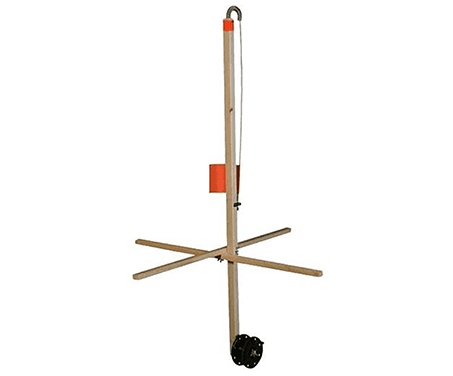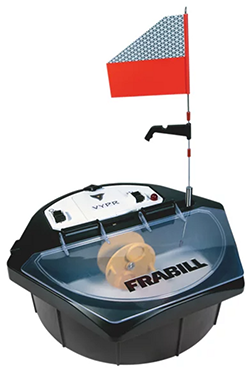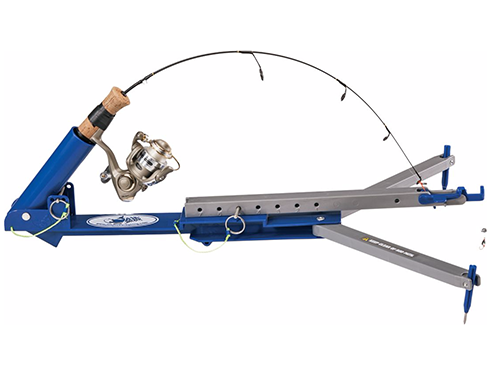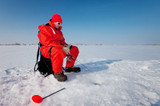Ice Fishing with Tip-Ups: How to Spread Out and Catch Trophies
Ice fishing with tip-ups isn’t just a way to enjoy the winter outdoors; it’s a strategic approach to catching those trophy fish that seem to elude even the most seasoned anglers.
Whether you’re a beginner eager to learn the ropes or an experienced angler looking to refine your technique, understanding the intricacies of ice fishing with tip-ups can transform your experience on the ice.
The Basics of Ice Fishing with Tip-Ups
Tip-ups are a type of fishing device commonly used in ice fishing. They are designed to allow anglers to fish multiple holes simultaneously, increasing the chances of catching fish. Here’s how they work:
- Structure: A tip-up is a simple device. It typically consists of a frame that sits on the ice surface, with a spool of line attached underneath. The frame can be made of wood, plastic, or metal and is designed to straddle a hole drilled in the ice.
- Fishing line and bait: The spool holds the fishing line, which extends down through the hole in the ice into the water below. At the end of the line, you attach your bait and hook. The bait used can vary depending on the target species, but it often includes live minnows or other small fish.
- Signal flag: The defining feature of a tip-up is the signal flag. This flag is connected to the spool so that when a fish takes the bait and pulls the line, the spool turns and triggers the flag to “tip up,” hence the name. This flagging mechanism alerts the angler that a fish has taken the bait.
- Hands-free fishing: One of the main advantages of using tip-ups is that they allow for hands-free fishing. Anglers can set up multiple tip-ups over a spread-out area. Try placing tip-ups near drop-offs, saddles, points, weed lines, rock piles, and other bottom contours to your bait in prime locations and cover different depths. This way, they can target more water and increase their chances of catching fish.
- Target species: Tip-ups are effective for targeting a variety of fish species that are active under the ice, such as pike, walleye, trout, and perch.
- Regulations: Ice fishing regulations vary by region, including the number of tip-ups or lines an angler can use at one time, so it’s always a good idea to check local fishing regulations.
Essential Ice Fishing Gear for Using Tip-Ups
Equipping yourself with the right gear can mean the difference between landing a trophy fish and losing your catch while ice fishing. At FISH307, we offer several great options to ensure your ice fishing trip is successful.

Choose the Right Tip-Ups
Choosing the right tip-ups is not just about preference; it also impacts whether the fish bite. The Heritage Laker Standard Tip-Up's traditional cross-base-style design and stainless steel trip level provide durability and smooth operation.

The Frabill Vyper Aerated Tip-Up incorporates built-in aeration to prevent ice buildup, a 2-ball-bearing reel for sensitivity, and high-visibility reflective-flag dual-trip settings for optimal visibility.

The JawJacker Hook Setting Tip-Up revolutionizes hooksets, accommodating various rod lengths and angles. This innovative device, resembling a bear trap, is designed for efficiency and effectiveness. It holds your rod in a bent position, and upon a fish strike, the rod snaps up, securing the catch. It’s compact, durable, and compatible with most ice rods, and adjustable for various fish sizes and bait weights.
Other Essential Gears for Ice Fishing
Complement your tip-up setup with additional gear from FISH307, including wet flies like Streamer Fly in Marc’s and Rainbow Smelt for a wider bait selection. Mimicking small baitfish, these flies attract larger game fish, offering a practical approach to ice fishing.
Consider the Flying Darter from A Band of Anglers for long-distance casting and a subtle swimming action. This darter plug is designed to catch big fish. It can be effective in deeper waters where big fish often lurk during winter, and its movement and vibrations can attract fish from a distance, drawing them toward your ice hole.
Ensure comfort and convenience with the HT Siberian Hardcore Ice Gear Ice Box. With its extra-thick padded foam seat and a compartment below for storage boxes, snacks, beverages, and live bait, this gear offers a versatile and comfortable solution for your ice-fishing needs.
Setting Up Your Ice Fishing Tip-Ups
Going ice fishing involves more than just enduring the chilly temperatures; it’s about perfecting the setup of your tip-ups. By following these steps, you can ensure that your tip-ups are ready for a fruitful day on the ice.
- Drill holes in the ice: Drill holes for your tip-ups using your ice auger. The number of holes depends on local regulations and how many tip-ups you plan to use. Make sure the holes are spaced adequately apart to cover a wider area.
- Clear the holes: Use the skimmer to remove any ice chips or slush from the holes to prevent them from refreezing quickly.
- Set up the tip-ups: Place a tip-up over each hole. Ensure it’s securely positioned and stable. Your tip-up should sit flush against the ice if it has a base.
- Rig the line: Attach your bait to the hook at the end of the tip-up line. The depth at which you set your bait is crucial and can vary depending on your target fish. Generally, setting the bait just above the bottom or mid-depth is a good starting point.
- Set the trigger and flag: Once your bait is set at the desired depth, engage the trigger mechanism on the tip-up. When a fish takes the bait, the movement of the line will release the flag, signaling a bite.
- Adjust sensitivity: Depending on your tip-up model, you may be able to adjust the sensitivity. This is particularly useful in windy conditions or when targeting fish with a gentle bite.
- Monitor your tip-ups: Keep a close eye on your tip-ups for any sign of activity. A raised flag means it's time to check the line.
- Respond to a bite: When you see a flag up, approach the tip-up calmly. Gently and slowly pull the line to check for resistance, indicating a fish is on the line. If you feel a fish, give a firm tug to set the hook.
- Re-bait and reset: After catching a fish or checking a false alarm, re-bait your hook if necessary and reset the tip-up.
How to Spread Out Your Tip-Ups
The optimal spacing and placement of your tip-ups depend on several factors, including the size of the area you’re fishing in, the type of fish you’re targeting, and the underwater topography. Here are some general guidelines to help you strategically spread out your tip-ups:
- Spacing: Space your tip-ups about 15 to 25 feet apart. This distance allows you to cover a broad area without the lines getting tangled. However, the specific spacing can vary based on the size of the water body and the clarity of the ice and water. In clearer conditions, fish might be more easily spooked, so wider spacing could be beneficial.
- Depth variation: Place your tip-ups at different depths to explore various water columns. Fish might be active at different depths depending on the time of day, temperature, and other environmental factors. For instance, you might set some tip-ups in shallow areas near the shore and others in deeper waters.
- Underwater features: Pay attention to the underwater topography. Fish often congregate around structures like weed beds, drop-offs, submerged logs, or rock piles. Using a map or a fish finder can help you identify these key areas. Place some tip-ups near these features while also exploring open water areas.
- Fish behavior and preferences: Consider the species of fish you’re targeting. For example, walleye are often found near the bottom, while northern pike might cruise at mid-depths. Adjust the placement of your tip-ups accordingly.
- Visibility and accessibility: Ensure that you can see each tip-up clearly from a distance and can access them quickly and safely when a flag indicates a bite. Avoid placing tip-ups in areas where navigating might be difficult due to uneven ice or obstacles.
- Wind and current: Take into account the direction of the wind and any water currents under the ice. These can affect how your bait moves and where fish are likely to feed.
Advanced Ice Fishing Strategies with Tip-Ups
Make the most of your ice fishing trip by tweaking how you use your tip-ups. Understanding how to jig correctly and find fish can help you optimize your tip-up positioning and spread and lure bigger fish toward your line.
How to Master Jigging Techniques
Jigging adds an interactive element to tip-up fishing. Create deliberate vertical movements in the bait to attract fish. Experiment with various jigging motions, speeds, and patterns.
Mastering jigging techniques is effective for catching species like perch and walleye. Consider tip-ups with built-in jigging features for added convenience, mimicking natural bait movements and adding versatility to your ice fishing tackle box.
Fish Finding Strategies for Trophy Catches
Use technology for a more productive ice fishing experience. Fish finders like Humminbird and underwater cameras help locate fish beneath the ice. Once you’ve identified potential hotspots using these devices, the next step is to drill test holes.
Continue drilling until you find signs of fish activity; scattering schools of baitfish or birds congregating around a certain area can indicate the presence of large predatory trophy fish.
Dealing with High Winds
High winds can pose challenges when using tip-ups, leading to false alarms or missed bites. Use windbreaks or specialized tip-up flags designed for stability in windy conditions. These accessories minimize false signals and ensure accurate detection when a fish takes the bait.
Solving the Problem of Frozen Lines
Combat frozen lines in sub-zero temperatures by regularly checking for ice buildup. Use antifreeze fishing line treatments or apply ice-fighting additives like propylene glycol or sunflower oil for flexibility in freezing conditions.
Ensuring Safety While Ice Fishing with Tip-Ups
Ice fishing with tip-ups is a rewarding winter pastime, but you must adhere to safety guidelines. Take the following precautions to ensure a safe and enjoyable experience on the ice.
- Check ice thickness: Before venturing onto the ice, verify its thickness. Use an ice auger to drill test holes and measure ice depth. A minimum of 4” of ice is generally safe for a single angler, but thicker ice is necessary for groups. Always check local ice conditions and adhere to safety recommendations.
- Fish with a buddy: Never ice fish alone. Having a fishing buddy not only improves the overall experience but can help in case of emergencies. Share safety responsibilities, such as checking ice thickness and being prepared for unexpected situations like medical emergencies or wildlife attacks.
- Wear a life jacket: Wearing a life jacket is a non-negotiable safety measure. In the event of an accident, a life jacket provides buoyancy and increases the chances of a safe rescue.
- Carry ice picks: Always carry a pair of ice picks, preferably attached to a lanyard worn around your neck. In case of an accidental ice break, ice picks can aid in self-rescue by providing traction on the ice, enabling you to pull yourself out of the water.
- Use brightly colored tip-up flags: Enhance visibility, especially during low-light conditions, by using brightly colored tip-up flags. This not only helps in monitoring your lines but also ensures that others on the ice can see your fishing activity, reducing the risk of collisions with other anglers or snowmobilers.
- Stay informed about the weather: Monitor weather forecasts and be prepared for changing conditions. Sudden temperature drops, high winds, or snowfall can affect ice stability. Stay updated to make the right decisions about when and where to ice fish.
- Set up near others: When choosing a fishing spot, consider setting up near other anglers. This not only promotes a sense of community but also provides immediate assistance in case of emergencies. Fellow anglers can also share insights about local ice conditions.
How to Clean and Maintain Your Tip-Ups?
Proper maintenance is the key to ensuring your tip-ups remain ready for action during each ice fishing expedition. Follow these essential tips to clean and maintain your tip-ups effectively.
Regular Cleaning
After every use, give your tip-ups a thorough cleaning to remove accumulated ice, dirt, and debris. Pay close attention to moving parts such as spools and flag mechanisms.
Use a soft brush or microfiber cloth to actively wipe away ice and ensure that no residue hampers the functionality of crucial components. Apply a lubricant, such as WD-40 or silicone-based spray, to moving parts to prevent freezing and maintain smooth operation.
Storing Your Tip-Ups: Do’s and Don’ts
Avoid tightly winding the line on the spool during storage, as this can lead to memory issues (retaining the shape of the spool), which can impact performance. Instead, loosely spool the line to maintain its integrity.
Store your tip-ups in a cool, dry place, protecting them from extreme temperatures and environmental elements. Avoid exposing them to direct sunlight or damp conditions, as this can lead to corrosion.
For a Successful Ice Fishing Trip Shop Tip-Ups at FISH307
Gear up with quality tip-ups from FISH307 to elevate your ice fishing experience and maximize your chances of a successful catch. Whether you’re a seasoned angler or a beginner, we’ve got the products you need.
Contact us online or call us today for professional advice and explore our range of tip-ups. Ice fishing with tip-ups has never been this rewarding!
Recent Posts
-
Ice Fishing Safety 101: What Every Angler Needs To Know
Ice fishing offers a unique thrill, but safety should always come first. Knowing the basics of ic
-
Ice Fishing Season Prep: Your Essential Pre-Ice Checklist
When the lakes start freezing, it’s time to swap your boat for an ice auger. But before you hit the





